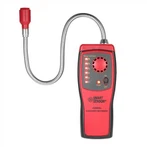The basic idea behind an anemometer is to immerse a thin wire in the fluid, which is then heated by an electric current to a temperature greater than the fluid, hence the term "hot wire." The temperature of the wire will decrease as the fluid travels vertically through it, removing some of the heat generated by the wire. It may be inferred from the theory of forced convection heat exchange that there is a correlation between the heat Q lost by the heat line and the fluid's velocity v. Two brackets are tensioned with a short, thin wire to form the basic structure of hot wire probes.Metals with high melting points and good ductility, such platinum, rhodium, and tungsten, are typically used to make metal wires. The little probe is only 1m in diameter and 0.2mm in length, whereas the typically used wire is 5m in diameter and 2mm in length.
The hot wire probe can also be produced as double wire, three wire, oblique wire, V shape, X shape, and other shapes depending on the application. Hot wire probes must be calibrated prior to use. Metal film probes, which are occasionally used to substitute metal wire in order to increase strength, are typically made of a thin metal film that is sprayed over a thermally insulating substrate and are referred to as thermal film probes. Dynamic calibration is performed in a known pulsating flow field or by adding the anemometer's heating circuit. Static calibration is performed in a particular standard wind tunnel by monitoring the connection between flow rate and output voltage and creating a standard curve.The last pulsating electrical signal is used to verify the frequency response of the hot-wire anemometer. If the frequency response is not good, the corresponding compensation circuit can be used to improve it.
Three categories can be used to categorize the flow velocity measurement range from 0 to 100 m/s: low speed (0 to 5 m/s), medium speed (5 to 40 m/s), and high speed (40 to 100 m/s). The anemometer's thermal probe is utilized for measurements between 0 and 5 m/s, its rotor probe is suited for flow velocities between 5 and 40 m/s, and its pitot tube can be used for high-speed observations. Temperature is another factor to consider when choosing an anemometer's flow probe. Typically, an anemometer's thermal sensor is around +-70C in temperature. The unique anemometer's rotor probe has a 350C temperature limit. Above +350C, pitot tubes are utilized.
Thermal probe of anemometer
The cold impact airflow is what drives the thermal probe of an anemometer to remove heat from the thermal element, and with the aid of an adjustment switch to maintain a constant temperature, the adjustment current is proportional to the flow rate. The precision of the measurement data is impacted when utilizing thermal probes in turbulent flow because airflow strikes the thermal element simultaneously from all directions. Thermal anemometer flow sensors typically have higher indications than rotor probes when detecting in turbulent flow.When measuring pipelines, the aforementioned behaviors can be seen. It may happen even at modest speeds, depending on how the turbulence in the pipe is managed. As a result, the pipeline's straight section should be used for the anemometer measuring method. D is the pipe diameter in centimeters, hence the starting point of the straight line must be at least 10 D in front of the measurement site, and the end point must be at least 4 D behind the measurement point. There must be no obstruction of any kind to the fluid cross section. (Adjacent surfaces, resuspension, items, etc.)
The revolving wheel probe of the anemometer operates on the basis of translating rotation into an electrical signal. The rotating wheel's rotation is first "counted" by a proximity induction head, which produces a pulse series that is afterwards converted by the detector. the speed value, please. The anemometer's large-diameter probe (60mm or 100mm) is appropriate for monitoring turbulent flow with medium and moderate flow velocities (such as at the pipe outlet). The anemometer's small-diameter probe is better suited for detecting airflow in pipelines that have cross sections that are more than 100 times greater than the cross section of the excursion head.






